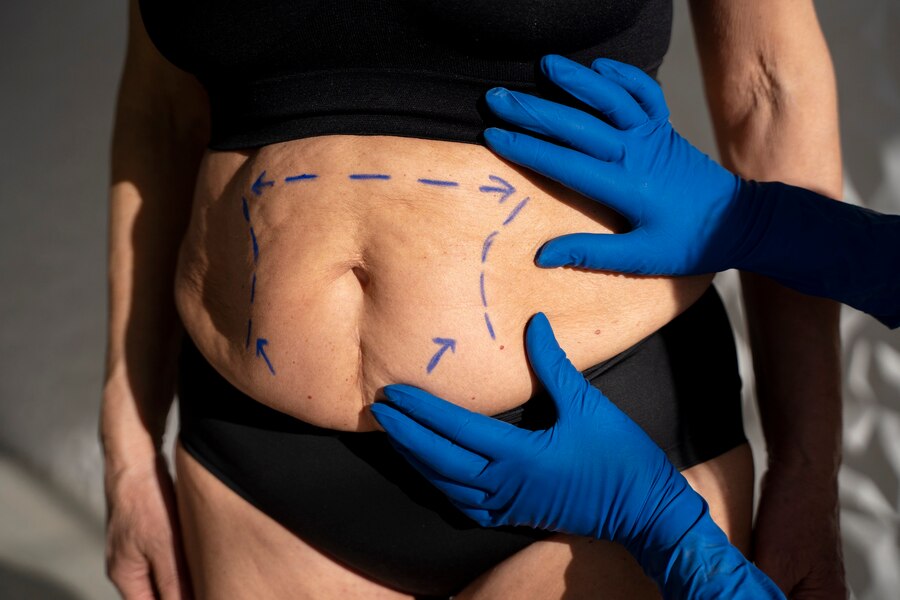Comparing CoolSculpting and Liposuction: Which Is Safer?

Comparing CoolSculpting and Liposuction: Which Is Safer?
Looking to shed stubborn fat and sculpt your ideal physique? Two popular options, CoolSculpting and liposuction, stand at the forefront of cosmetic procedures. But when it comes to safety, which reigns supreme? In this blog, we delve into the world of body contouring, comparing CoolSculpting and liposuction head-to-head. From their mechanisms of action to potential risks and benefits, we’ll uncover the nuances that can help you make an informed decision about the safest route to achieving your aesthetic goals. Let’s explore the science behind these transformative treatments.
Introducing CoolSculpting and Liposuction
CoolSculpting and liposuction represent two distinct approaches to body contouring, each with its own set of benefits and considerations. CoolSculpting, a non-invasive procedure, utilizes controlled cooling technology to target and freeze fat cells, which are then naturally eliminated by the body over time. On the other hand, liposuction is a surgical technique that involves the physical removal of fat cells through suction, typically performed under local or general anesthesia. Both procedures aim to sculpt and enhance body contours, but their methods and outcomes differ significantly. Understanding these nuances is essential for individuals considering cosmetic interventions to achieve their desired aesthetic goals.
Understanding Body Contouring
Body contouring encompasses a range of cosmetic procedures designed to reshape and redefine the body’s contours. Whether targeting stubborn pockets of fat, loose skin, or muscle definition, body contouring treatments aim to enhance the body’s overall appearance and proportions. These procedures can be surgical or non-surgical, ranging from liposuction and tummy tucks to CoolSculpting and laser treatments. Understanding the various options available, along with their benefits, limitations, and potential risks, is crucial for individuals seeking to address specific areas of concern and achieve their desired physique.
Mechanisms of Action: How They Differ
The mechanisms of action behind CoolSculpting and liposuction underscore their fundamental differences in approach. CoolSculpting employs a process known as cryolipolysis, which selectively targets and freezes fat cells without damaging surrounding tissues. Once frozen, the fat cells undergo apoptosis, a natural cell death process, and are gradually metabolized and eliminated from the body over several weeks to months. In contrast, liposuction involves the mechanical removal of fat cells through suction, using specialized cannulas inserted through small incisions in the skin. This direct extraction allows for immediate fat reduction in targeted areas, providing more immediate results compared to the gradual fat loss seen with CoolSculpting.
Safety First: A Primary Concern
When considering any cosmetic procedure, safety should always be a top priority. Both CoolSculpting and liposuction are generally considered safe when performed by experienced and qualified practitioners in accredited facilities. However, as with any medical intervention, there are inherent risks and potential complications associated with each procedure. Understanding these risks, such as infection, bruising, swelling, or adverse reactions to anesthesia, is essential for informed decision-making. Patients should undergo a thorough evaluation and consultation with their healthcare provider to assess candidacy, discuss expectations, and address any concerns regarding safety before proceeding with treatment.
CoolSculpting: Non-Invasive Fat Reduction
CoolSculpting has gained popularity as a non-invasive alternative to surgical fat reduction procedures like liposuction. The procedure, also known as cryolipolysis, targets localized areas of fat using controlled cooling technology. During a CoolSculpting session, a specialized applicator is applied to the treatment area, delivering precisely controlled cooling to freeze and crystallize underlying fat cells. Over time, the frozen fat cells undergo apoptosis, or cell death, before being naturally eliminated by the body’s lymphatic system. One of the key advantages of CoolSculpting is its ability to reduce fat without surgery, anesthesia, or downtime, making it an attractive option for individuals seeking a non-surgical approach to body contouring.
Liposuction: Surgical Fat Removal
Liposuction remains one of the most commonly performed cosmetic procedures for fat removal, offering more immediate and dramatic results compared to non-invasive alternatives like CoolSculpting. Also referred to as lipoplasty or suction-assisted lipectomy, liposuction involves the surgical removal of excess fat deposits from specific areas of the body, such as the abdomen, thighs, hips, buttocks, or arms. The procedure is typically performed under either local anesthesia with sedation or general anesthesia, depending on the extent of treatment and patient preference. Using a thin tube called a cannula, the surgeon manually breaks up and suctions out targeted fat cells, sculpting and contouring the desired areas to achieve a smoother, more proportionate silhouette.
Comparing Treatment Processes
The treatment processes for CoolSculpting and liposuction differ significantly in terms of invasiveness, duration, and recovery. CoolSculpting sessions are typically performed as outpatient procedures in a medical spa or cosmetic clinic setting, with no anesthesia required. During the treatment, patients may experience a mild cooling sensation and temporary discomfort as the targeted area becomes numb. Each CoolSculpting session lasts approximately 35 to 60 minutes, depending on the size and number of areas being treated. In contrast, liposuction is performed in a surgical suite or hospital operating room under anesthesia, with the duration of the procedure varying based on the extent of treatment and technique used. Recovery from liposuction typically involves some degree of swelling, bruising, and discomfort, with patients advised to wear compression garments and limit physical activity during the initial healing period.
Anesthesia Considerations
Anesthesia plays a crucial role in both CoolSculpting and liposuction procedures, albeit to different extents. CoolSculpting is a non-invasive treatment that does not require anesthesia, as it involves minimal discomfort and no incisions. Patients undergoing CoolSculpting can remain awake and comfortable throughout the procedure, reading, working on their laptops, or simply relaxing. In contrast, liposuction is a surgical procedure that often requires the use of anesthesia to ensure patient comfort and safety during the operation. Depending on the extent of treatment and patient preference, liposuction may be performed under local anesthesia with sedation or general anesthesia, administered by a board-certified anesthesiologist. The choice of anesthesia will be discussed and determined during the pre-operative consultation between the patient and their surgical team.
Recovery Time: What to Expect
Understanding the expected recovery time is essential for individuals considering CoolSculpting or liposuction as part of their body contouring journey. With CoolSculpting, there is minimal to no downtime, allowing patients to resume normal activities immediately after treatment. Some temporary side effects, such as redness, swelling, bruising, and numbness, may occur but typically resolve within a few days to weeks. In contrast, liposuction recovery involves a more significant downtime, with patients advised to take time off work and refrain from strenuous activities for several days to weeks, depending on the extent of treatment and individual healing response. Compression garments may be recommended to minimize swelling and support the healing process, with final results gradually becoming apparent over the course of several months as the body heals and adjusts.
Potential Risks of CoolSculpting
While CoolSculpting is generally considered safe and effective for most patients, it’s essential to be aware of potential risks and side effects associated with the procedure. Common side effects may include temporary numbness, tingling, redness, swelling, bruising, and discomfort at the treatment site, which typically resolve on their own within a few days to weeks. Less common but more serious complications may include paradoxical adipose hyperplasia (PAH), a rare condition characterized by the enlargement of treated fat cells, or frostbite-like skin damage if the skin is not adequately protected during treatment. Additionally, patients with certain medical conditions, such as cryoglobulinemia or cold agglutinin disease, may not be suitable candidates for CoolSculpting due to increased risk of complications. Consulting with a qualified healthcare provider is essential for proper assessment and personalized treatment recommendations.
Potential Risks of Liposuction
Liposuction, like any surgical procedure, carries inherent risks and potential complications that patients should be aware of before undergoing treatment. Common risks include bleeding, infection, bruising, swelling, fluid accumulation (seroma), changes in skin sensation, contour irregularities, and asymmetry. More serious but rare complications may include blood clots, pulmonary embolism, anesthesia reactions, skin necrosis, or damage to underlying structures such as nerves, blood vessels, or organs. The risk of complications can be minimized by choosing a board-certified plastic surgeon with extensive experience in liposuction techniques, following pre and post-operative instructions diligently, and disclosing any relevant medical history or medications to your surgical team. Patients should undergo a thorough evaluation and discussion of potential risks and benefits during the consultation process to make an informed decision about treatment.
Long-Term Results: Sustainability Matters
When considering CoolSculpting or liposuction, understanding the long-term results and sustainability of fat reduction is crucial. CoolSculpting typically achieves gradual fat reduction over several weeks to months as the body naturally eliminates frozen fat cells. Once treated fat cells are eliminated, they do not return, providing long-lasting results as long as a stable weight is maintained through a healthy lifestyle. However, maintaining optimal results may require multiple treatment sessions for some individuals or addressing additional areas of concern over time. Conversely, liposuction provides more immediate and dramatic results, with a single procedure often sufficient to achieve desired fat reduction and contouring. However, maintaining results requires a commitment to healthy habits, including regular exercise and a balanced diet, to prevent new fat accumulation in treated areas and preserve the sculpted contours achieved through surgery.
The decision between CoolSculpting and liposuction boils down to personal preferences, desired outcomes, and individual considerations. At American Laser Med Spa, our mission is to transform lives by making people feel young, beautiful, and confident, while building a community centered on exceptional patient care. Your safety and satisfaction are paramount to us, and we’re here to guide you through your body contouring journey every step of the way. For personalized recommendations and to book your consultation, call us at 915-760-5123. Let’s embark on this transformative journey together!







